Dayna decided to be a cyborg for Halloween
And the costume was to be elaborate. Foam, electronics, magnets, 3D prints – it’d sport them all.
In the end it turned out alright, for something so rushed. (more…)

And the costume was to be elaborate. Foam, electronics, magnets, 3D prints – it’d sport them all.
In the end it turned out alright, for something so rushed. (more…)

Making costumes is fun! Fun, but worrisome. What if it looks like you’re just wearing a garbage bag – what if people think you’re dressed as literal garbage?
I mean, maybe you are dressed as garbage, and that’s okay. In that case, good job! But me, I wasn’t dressing as garbage.
No, I wanted to be Frank from Donnie Darko, complete with his bunny outfit.

(Frank's the one on the right)
The most distinctive thing about Frank is his mask. Conveniently it was also the most likely point of failure. Which made it a good place to start – if it turned out terribly, I could always fall back on my garbage idea.
The first step was to figure out what I was making. So out came the old notebook and a trusty pen.

Even when pencils are actually in the way, I prefer to draw in pen — it's more metal
Once the various angles were documented, it was time to commence fabrication – using a tried and true method called winging it.
But how to form the mask? I knew I’d be using polymer clay, but I wanted something to build off of – a wire-frame, if you will. I briefly considered using coat hangers, but my coats need those. Adjourning to Michael’s instead, it turns out they have something called “craft wire”, which comes in various gauges, wound in a circle. I settled on a 12 and a 14 gauge wire; 12 was coat hanger thick, and 14 slightly thinner.
After twisting the wires in place, I hot glued the joints as well.
Some wire and hot glue later

You may notice some rectangular loops – one on each side, near where the eyes would be, and one at the top. This is a rare example of planning ahead. I knew I’d need some way to keep it on my face, and decided on three-point elastic system. I wanted the connection points to be build into the framework, so I added those loops to the wire-frame.
Next, I wanted to fill it in, to give the polymer clay something to sit on. You know, so it didn’t droop through the gaps under its own weight. I wrapped the frame with aluminum foil, and used excess foil to build up mass in places like the brow and cheeks.
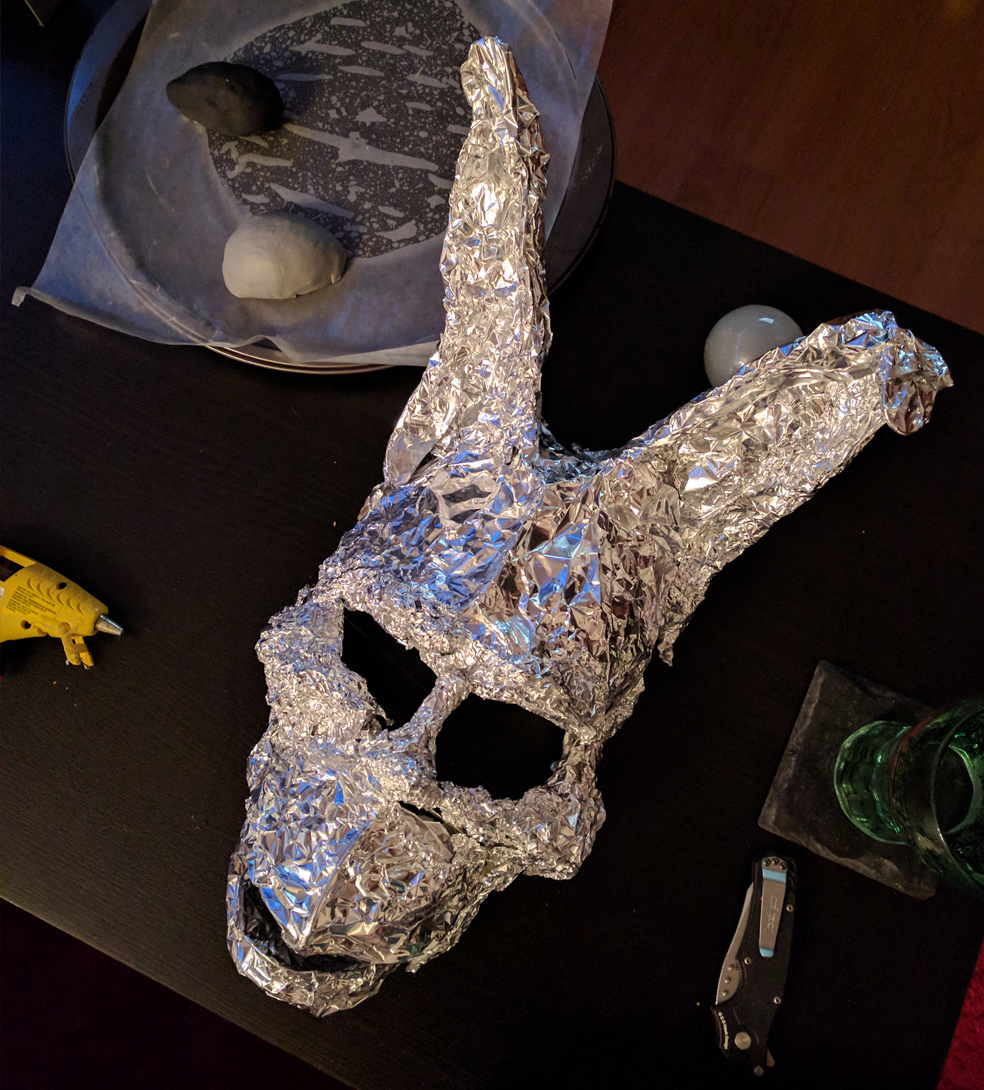
Next, I added mass with aluminum foil
Those lumps of grey and black in the background were how I tested and settled on making the eyes, respectively.

You can see one of the loops more clearly here
After some reading on the various polymer clay options, I settled on mixing silver and black Kato Polyclay (which I ordered from shadesofclay.com). This wasn’t the most time or labour efficient solution – which is an evasive way of saying it was the worst decisions of my life.
I spent hours mixing the clay, and my hands felt a bit bruised afterward. Keep in mind that I’m a large fellow with proportionally sized hands, and admirable grip strength, if the Telus World of Science is to be believed. In short, maybe don’t do it unless you really want to.
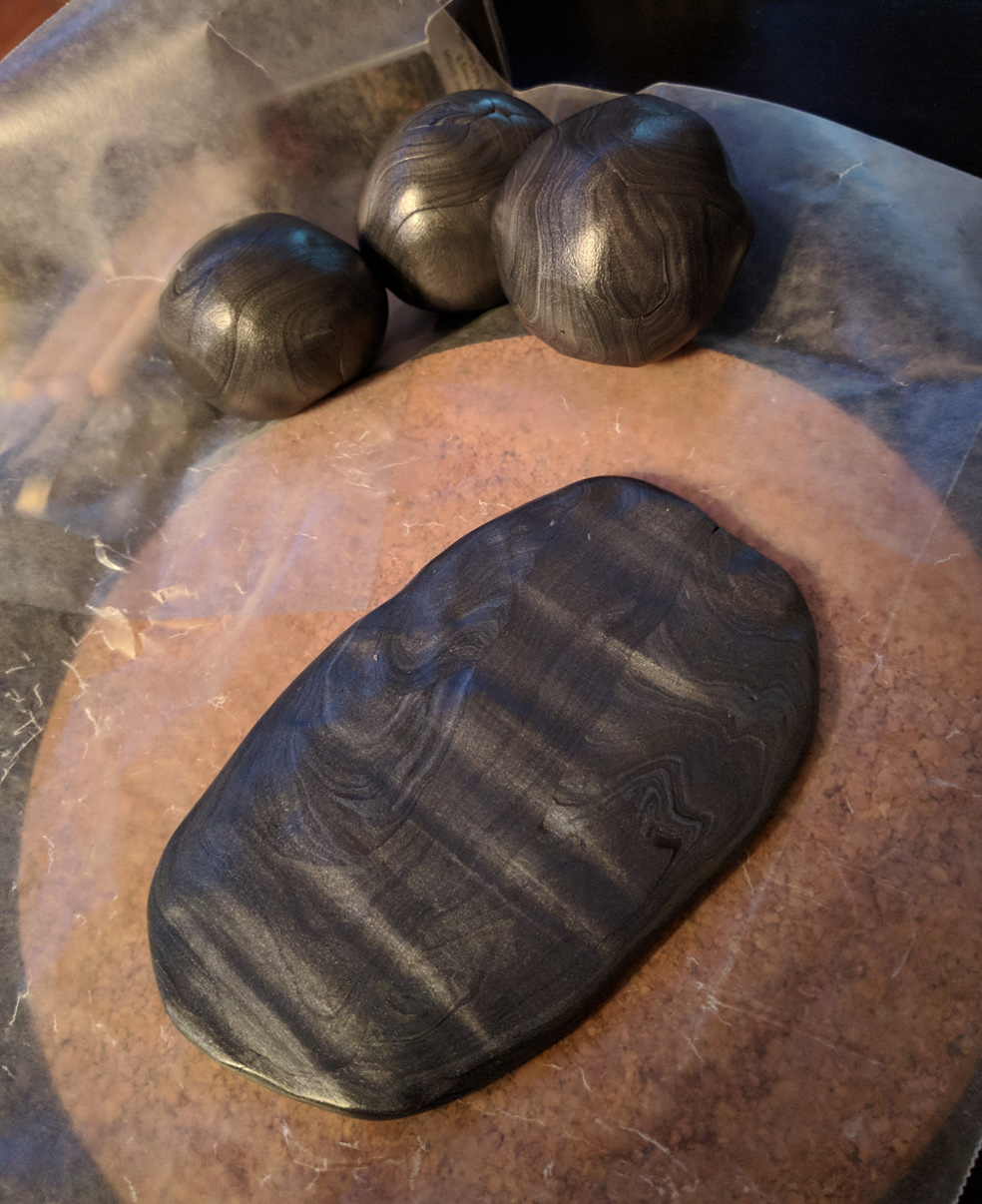
This is maybe a quarter of the polymer clay I mixed.
Because I wanted the eyes to light up, I made them with Pardo Translucent Art Clay. I made a form using a ball of tinfoil rough eye shape, covered in a layer of some black polymer clay I had leftover from my Witcher costume.
I cooked it in the oven, and then pressed a layer of the Pardo Translucent over it, and cooked that (times two).

Look, it's an eye!
Once a Pardo Translucent eye was cooked, I pulled it off the form. Conveniently, they came off pretty well – although the form was mostly destroyed after the second eye. Joke’s on it, though, Frank’s mask only has two eyes.
With the eyes complete, I set about the tedious task of skinning the mask. I did this over two days.
I’m not sure if it was necessary, but during the night I stored the excess clay in the fridge, and wrapped the mask in plastic – just in case.
Skinning the mask
Guys, I have a confession to make. Before, when I told you I started with the mask.. Well, that wasn’t entirely true. I started with the teeth.
I hope you can forgive me.
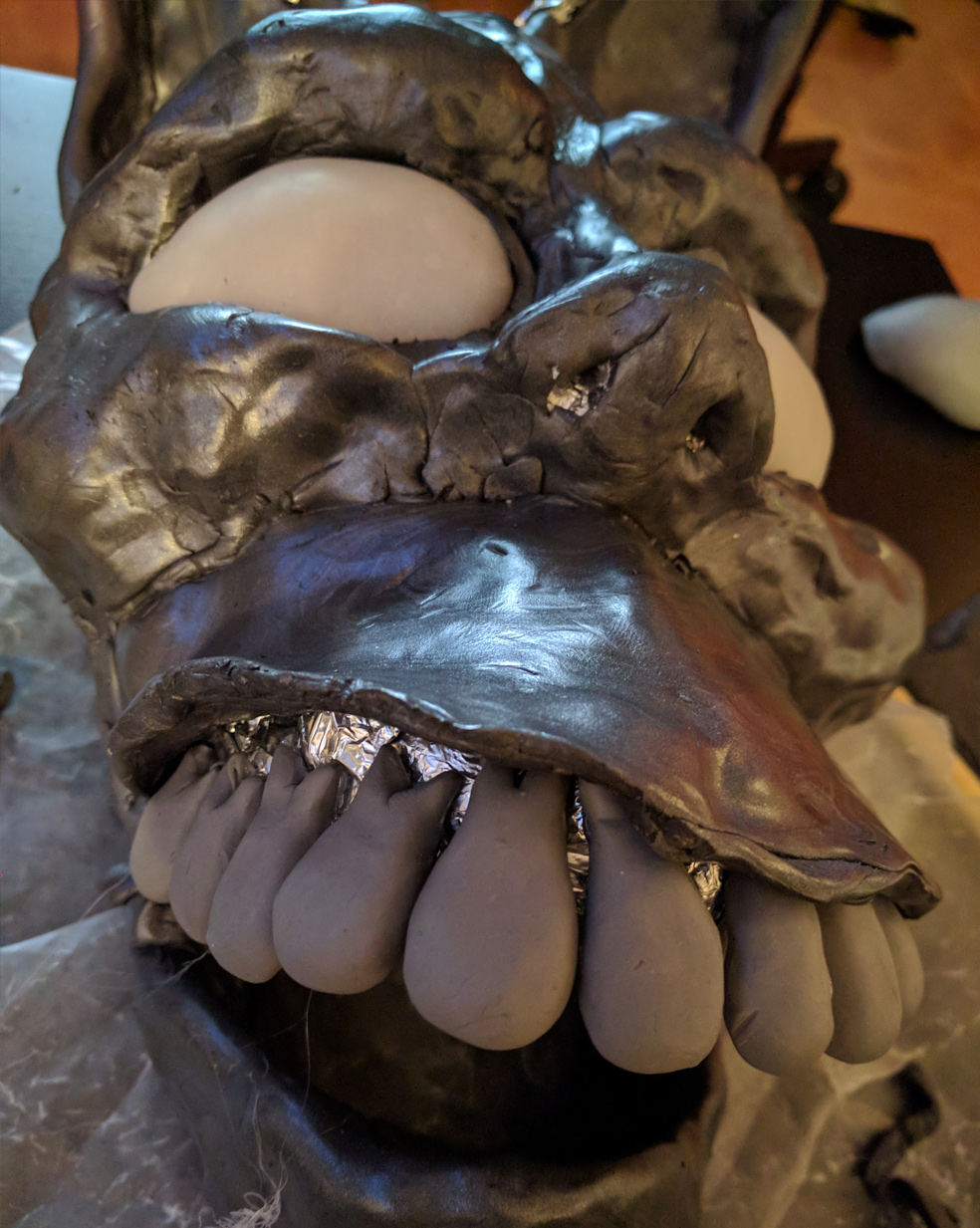
Doing a little dentistry
It turns out the trick to successful dentistry is surface area and hot glue.
I’d originally included the roots on the teeth to provide extra surface area, and to help prevent the teeth from falling out. It turns out this had the added benefit of cool bumps above the teeth – kind of like metal gums.

Skinned and ready to cook
With the mask both skinned and toothed, it was time to cook it – and boy was I nervous.
Luckily, it almost fit in my filthy oven. There’s a bit of a flat spot on the top of one ear, and at the bottom of his chin, where it touched the back wall and the oven door, respectively. I probably should have actually measured things before hand. Oh, well – I doubt anyone else would even notice.

I put two balls of aluminum foil inside it for support
Now, you’re probably thinking but, hey, how will you see?
Now that is a great question. When I was planning the mask, I decided I didn’t care about vision. I could look down and see through the mouth, or flip it up on my head if I really needed to see something.
I didn’t plan to move around much while wearing it.
At the last minute, (probably because people kept asking) I started to worry I’d made a terrible mistake. Panicked, I poked a tiny hole near one eye to look through. It worked fairly well, though I can only see one face at a time.

Bonus, I later learned that the neck of a corona bottle fits perfectly through the mask's mouth and into my own.
Once the polymer clay was hardened, I finished it with some paint and silver leaf Rub n’ Buff. Turns out it was super difficult to paint. The acrylic just seemed to run over it. I ended up eventually cleaning it up with a bit of acetone. The Rub n’ Buff was just as cool as always, though.

A bit of acrylic, and a bunch of Rub & buff. (Don't worry that glue gun isn't plugged in)
At this point, the inside was still aluminum foil, so I covered it with craft foam. This served the dual purpose of making it easier on my face, and more importantly, making it look better.
I also added some foam padding for comfort.

Whoa comfy (Here you can see the elastic loops again)

Oh, speaking of the elastic..

It's a little big on Dayna
I put off painting the teeth for quite a while. I wasn’t sure if I wanted to do it, and I was happy enough with the mask that I was worried about ruining it. In short, I was nervous.
I don’t have a lot of experience mixing paints, but I had a very particular colour in mind. I probably spent an hour just mixing and testing colours, trying to get that perfect shade of bone-white. (The trick was to add a bit of black.)
Eventually I got down to it, though.
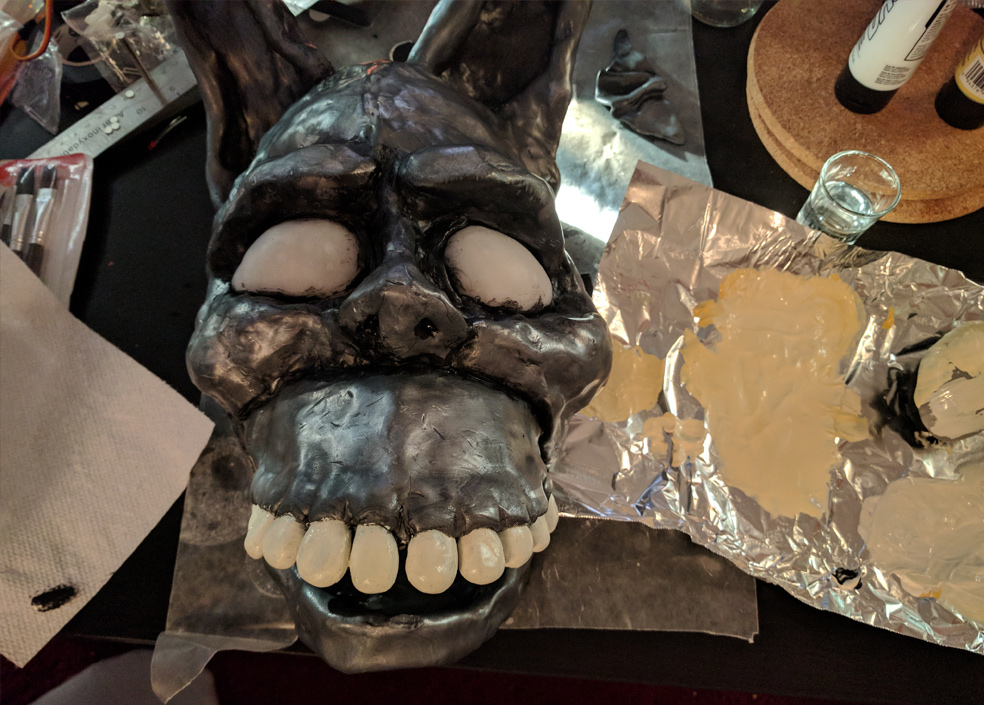
teeth whitening
I wanted the eyes to glow – but only sometimes. I wanted it to be sneaky.
After testing a bunch of different LEDs, I settled on white (I got them from bc-robotics.com). They ended up looking a little bit blue, but that’s okay.

So I got to soldering, which I hate. I think you can see the despair in my eyes.
In order to diffuse the light, I made a sort of cup of wax paper, and melted hot glue into it. I embedded each LED into one of the globs, and then glued them into the eyes.
From there extended a long wire. Long enough to travel down my sleeve toward my hand. It ended in a switch, which allowed me to turn the eyes on and off at will, with nary a motion.
That is, if I had a sleeve.

With the mask complete, it was time to work on the bunny suit. I wanted a pretty basic onesie, loose and long-limbed. Being too lazy to even look for a pattern, I just went for it.
I found some cool fabric when I was in Victoria, though I wish I’d gotten more. It turns out I had just barely enough. The hood is actually made of scraps.
Rabbit pants Starting the shirt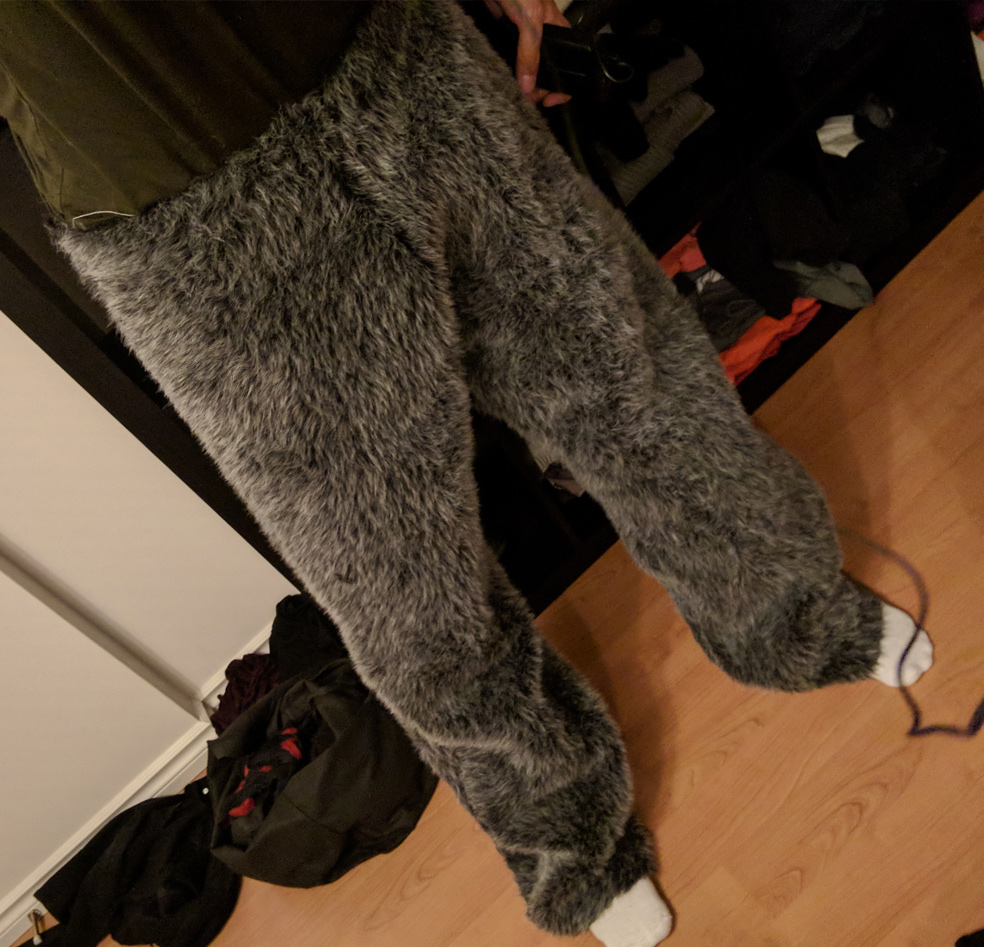

I wanted it to velcro at the front, where the white and grey fabric meet.

Almost there!
All that was left was to add the hood!
To help the hood stay in place, I used magnets to attach it to some metal on the mask’s upper-most elastic. This didn’t work as well as I’d hoped. I should have used more magnets, but I left that portion until the last minute. Oh well.
With the eyes off

With the eyes on

Here it is on instagram:

Chainmail, chainmail, chainmail. I got my mother to knit me chainmail.
Guys, I have a confession to make. I don’t know how to knit. I’ve never known how to knit, and it’s entirely possible I’ll never learn to knit. I know, I know. Knitting’s so trendy right now, but there you go, I’m ilkniterate.
But good news, once the knitted pieces magically appeared, I got on with my costume by spraying paint all over them.
Those wooden pieces are for the swords, shhh.
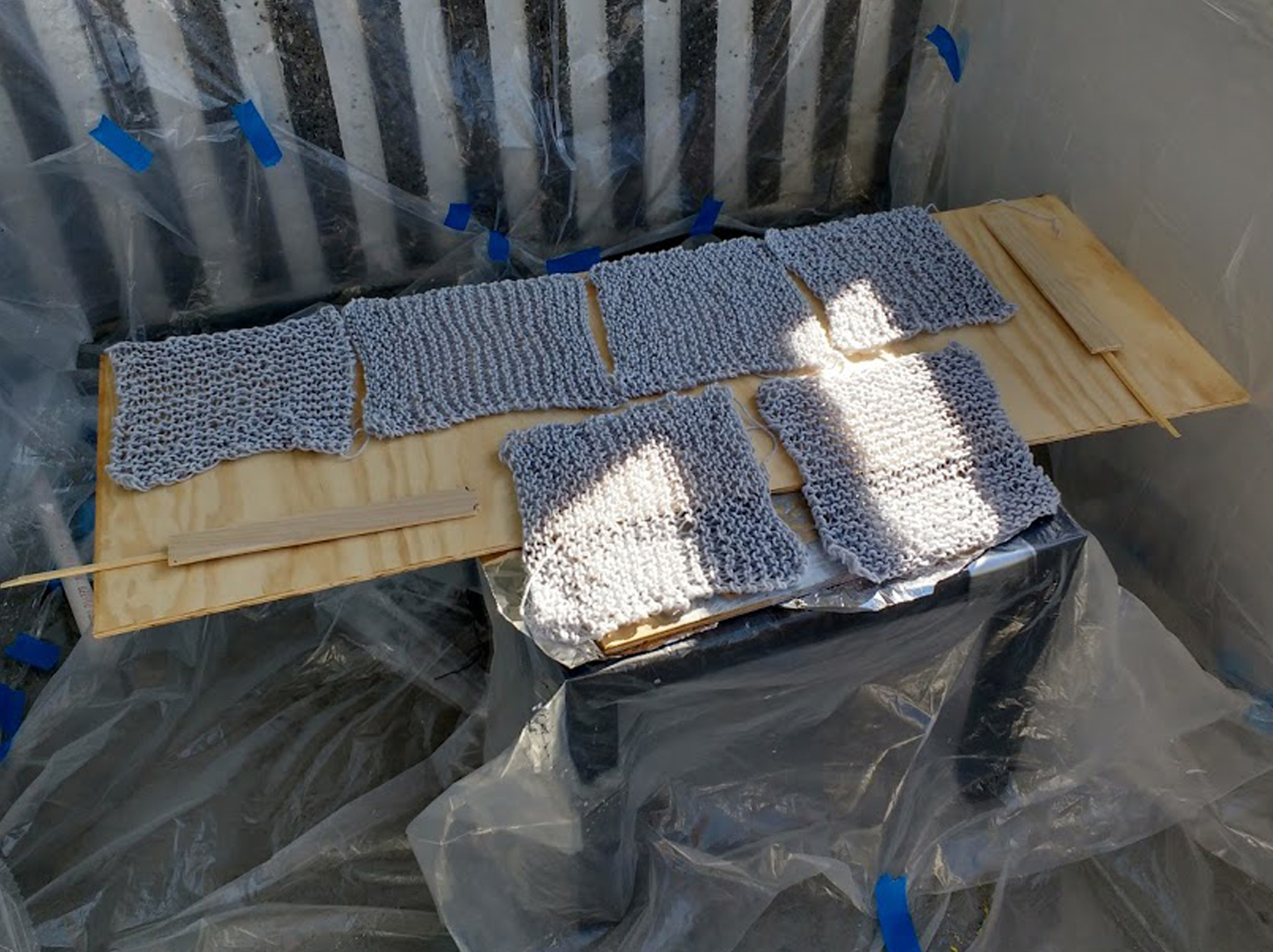
And through the magic of time-lapse!
All painted!
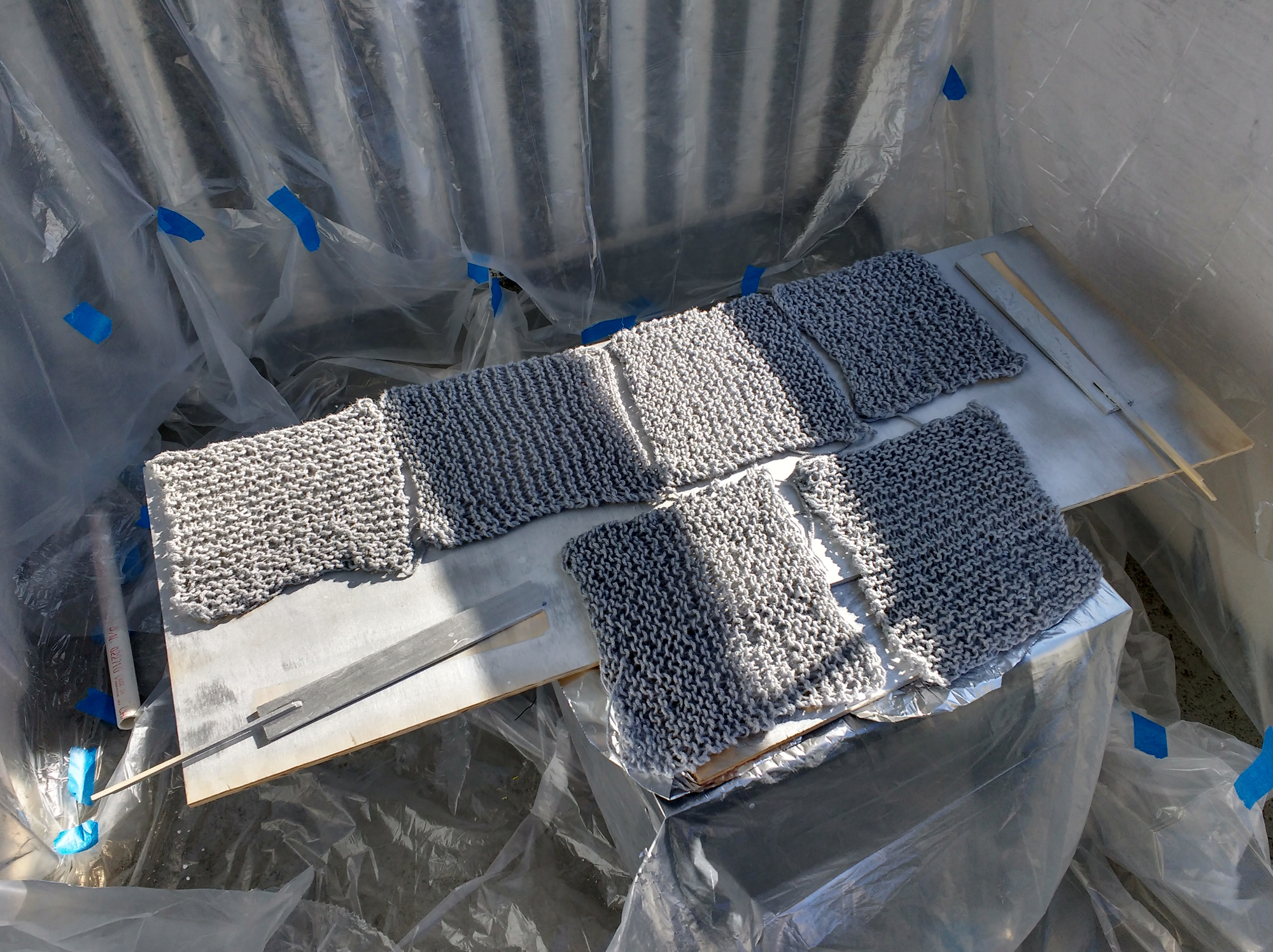
If you’re thinking Wow, those look pretty similar… — good eye!
Once the painting was done, it was time to turn them into armour. I wrapped them in fake leather, with a piece of thin, black craft foam between them, and sewed up the sides. Funny thing about this fake leather, it doesn’t go through the sewing machine well. It’s too… I don’t think sticky is the word, but there’s definitely too much friction. To get around this, I wrapped what I’d be sewing in tissue paper. It was a pain, but it worked.
You can't really see it, but there's a layer of thin foam in there
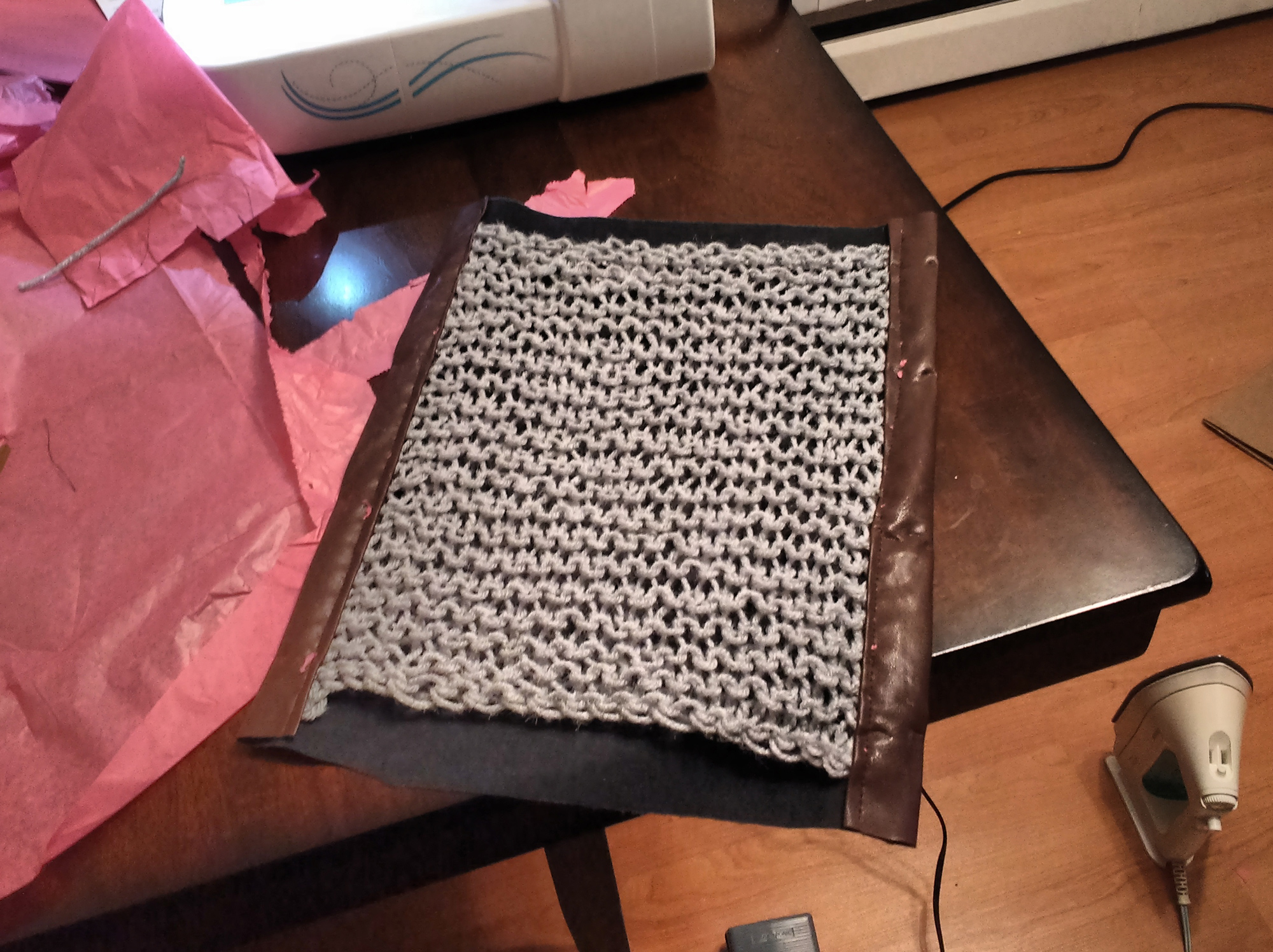
I added straps and buckles, as appropriate, and sewed it all together. I also lightly dusted some parts with brown spray paint to try to give the leather layering some texture. Beneath the arm pieces are some straps with velcro I sewed on.
Fast forward to this.
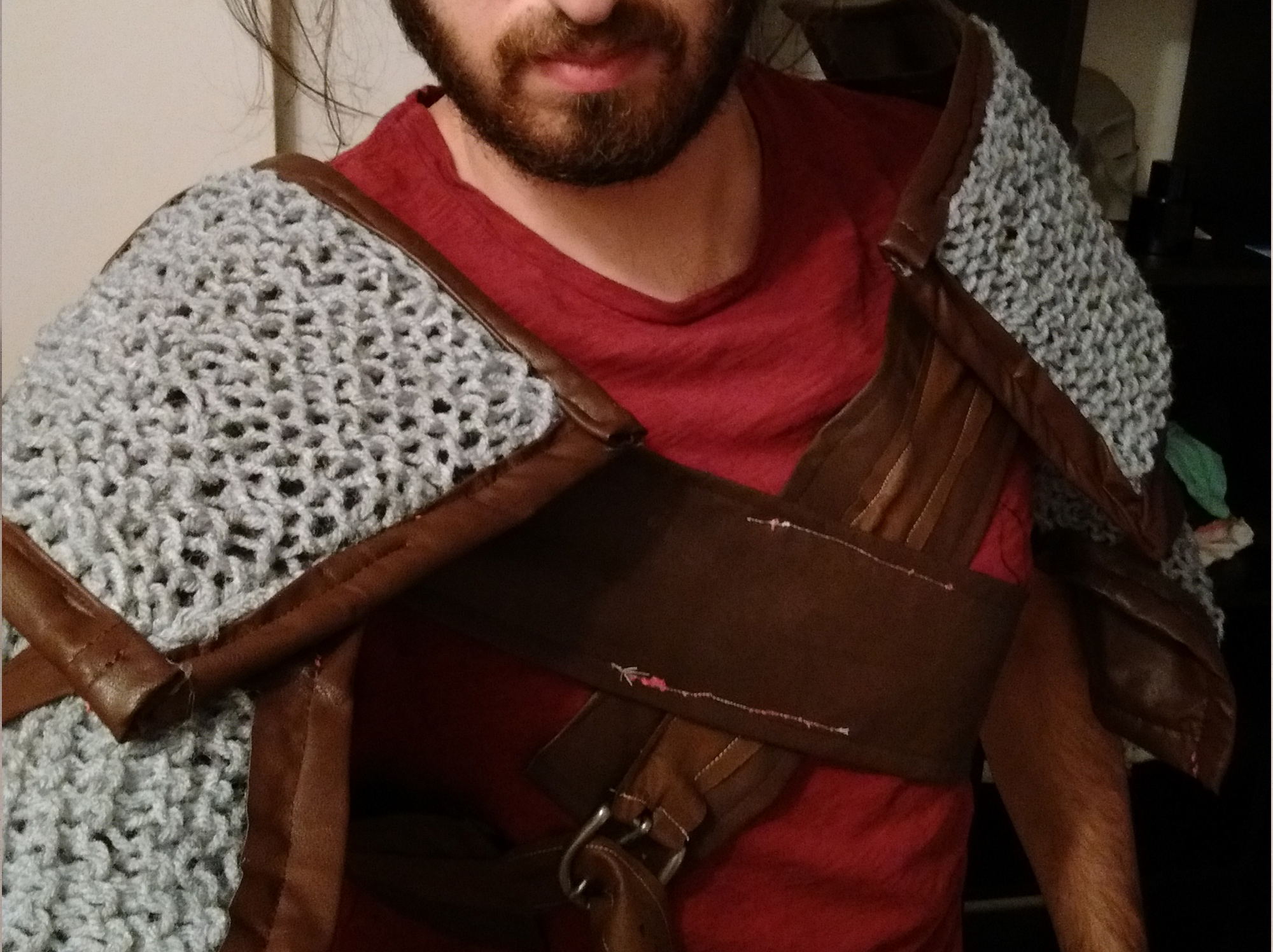
#Protip: If I was doing it again, I’d sew the pauldrons down so they didn’t flap around as much – or build them over something sturdier than the fake leather and a thin layer of craft foam.

EVA foam is really cool! I grabbed some from Home Depot, and some poster board at Staples.
The first step was making the pattern. I went through a few iterations here. I started by writing down my various sizes (anything I thought would come in handy) using some dollar-store measuring tape. That wasn’t super useful, so I half-heartedly wrapped my upper torso in plastic wrap and duct tape. Which is really hard to do by yourself! (Also it gets quite warm.)
That, and I ran out of duct tape half way through. The role I’d bought from Safeway didn’t include much at all.
Oh well, I figured. It’d give me an idea — so I drew some demarcation lines on it with a silver sharpie, and cut it off. Once I cut it open I had a better idea of the shapes I’d need.
Pretty rough, but good enough!
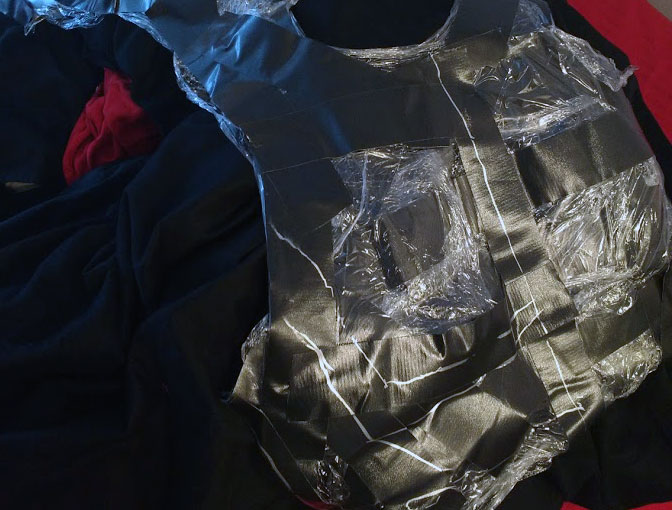
I drew those shapes onto poster board, and cut them out with an Exacto knife. Loosely taping them together, I donned my poster-board armour — just to get an idea how it looked.
I did this a few times, tracing and making small adjustments, until I was finally happy with the pattern. It looked something like this:
(Exactly like this)

Once I had the pattern, I pinned the pieces to the foam, traced them with a sharpie, and then cut the foam with a box cutter. I re-sharpened the box cutter after each one because man did the foam dull it fast. I also found the foam’s patterned side was the toughest to cut through, so I made sure to trace my patterns onto that side.
You may have noticed a cut along the bottom of the pectoral’s pattern. On the foam, I scooped out some of the foam here with my box cutter, angling the sides like a triangle. This would allow me to bend it easily, getting a nice crease, but no seam on the visible side. I’m kind of proud of how that turned out!
I setup my balcony as a work space (complete with table, camping chair, and extension cord) and covered it in plastic with the assistance of painters tape.
work space
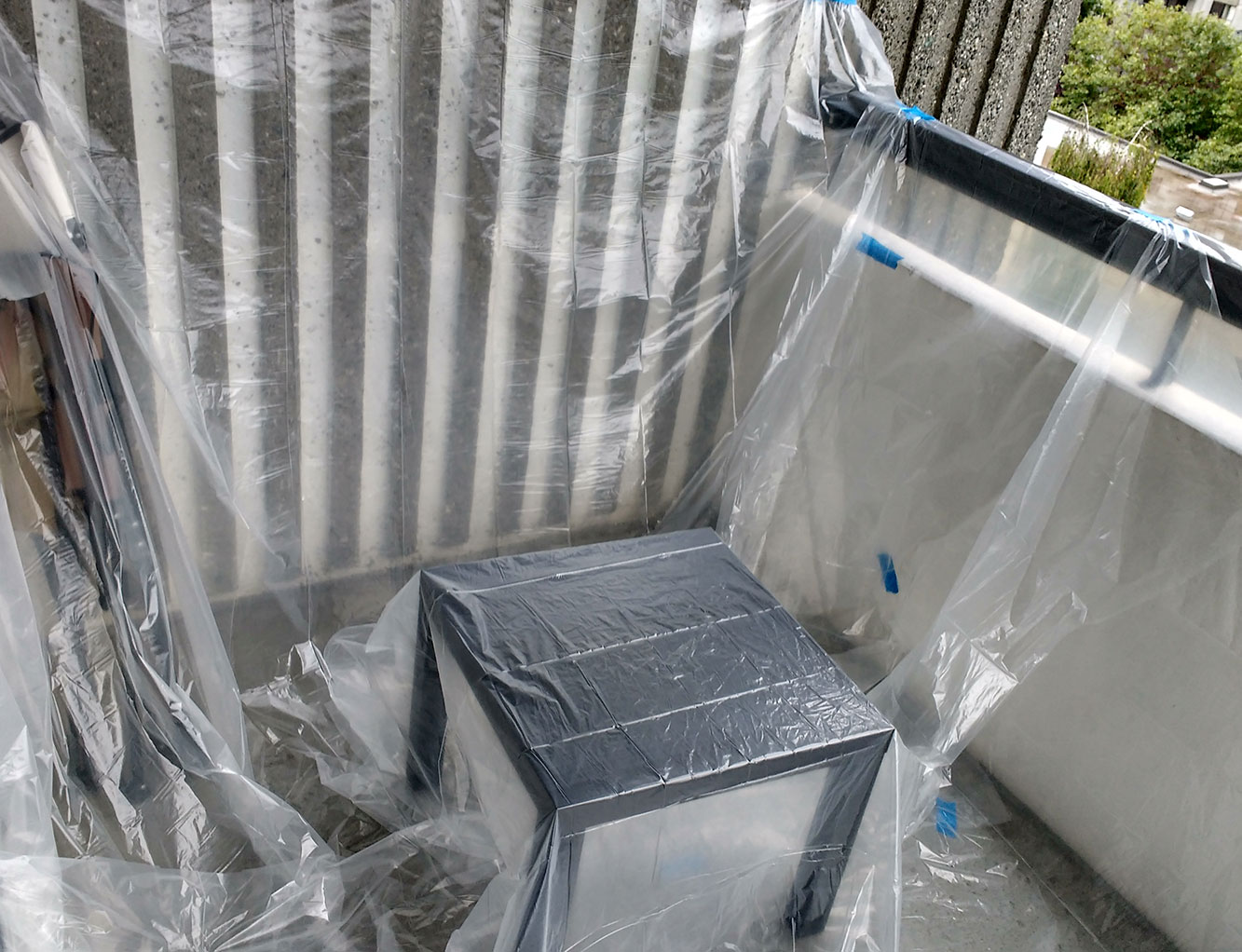
Once the foam was cut, I donned my mask and safety glasses, and used the rotary tool I bought to sand down the rounded edges. Prepare to be covered in foam dust. After that I sanded them with increasingly fine grits (I have 100, 220, and 320).
#safety

Then came the fun part — shaping the foam with the heat gun. I got the best results by really pulling the foam, and holding it in place for a bit while it cooled.
Once I had pieces of foam shaped it was time to join them. I had some trouble getting this to work the way I wanted, but eventually (through the reliable art of trial and error) I stumbled on a technique that seemed to work.
I used LePage contact cement

Once this is done, it’s probably best to give it some time to dry. But after that, you should have a nice, strong attachment! I also punched out some holes along the bottom (which you can see somewhere below).
The armour!

Before I painted, I went over the joints with some Kwik Sealk Caulk to smooth them out so as to be less noticeable seams. It wasn’t really necessary, but I figured I’d give it a try.
Caulked, as they say.
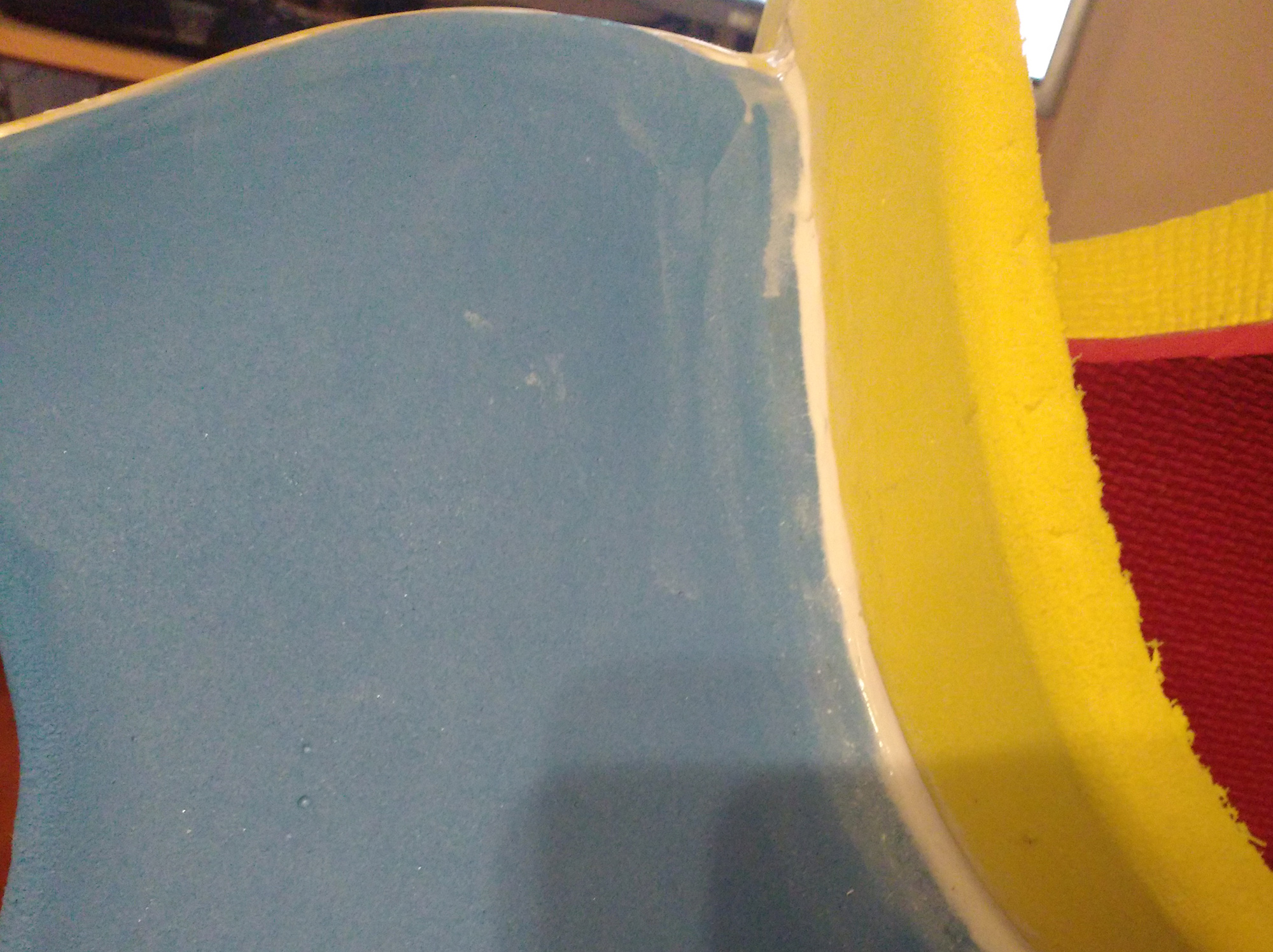
Once the caulk dried, I sprayed on a few coats of Plastidip (so cool!) to give it a nice rubber coating. coated!
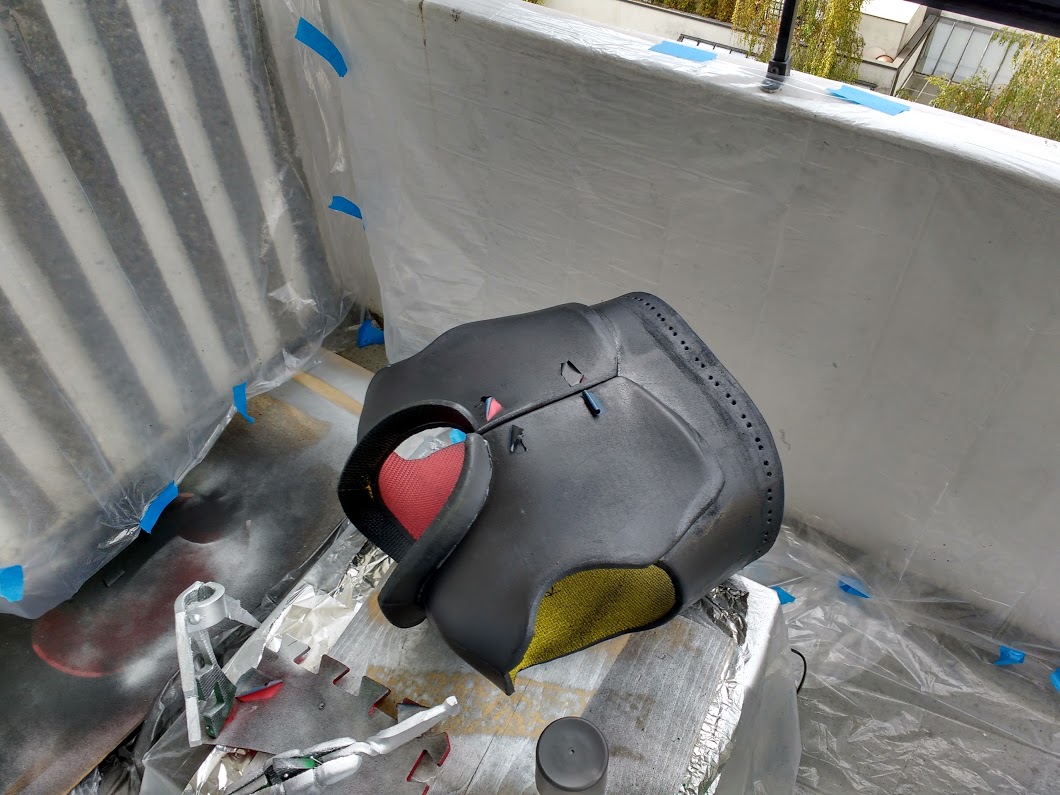
You’re probably wondering what those terrible flaps of painters tape are on the front. I put those there because I was going to glue some leather buckles to the armour. There’s another one on the side that you can’t see.
Once the Plastidip was dry, it was on to the spray painting! I roughed it up a little with watered down black paint and a wet rag, and then dry brushed various browns here and there to give it some texture, wear, and scratches. I also wove some leather through the holes I punched earlier (which I got in a giant bag of scraps from Michaels).
painted!
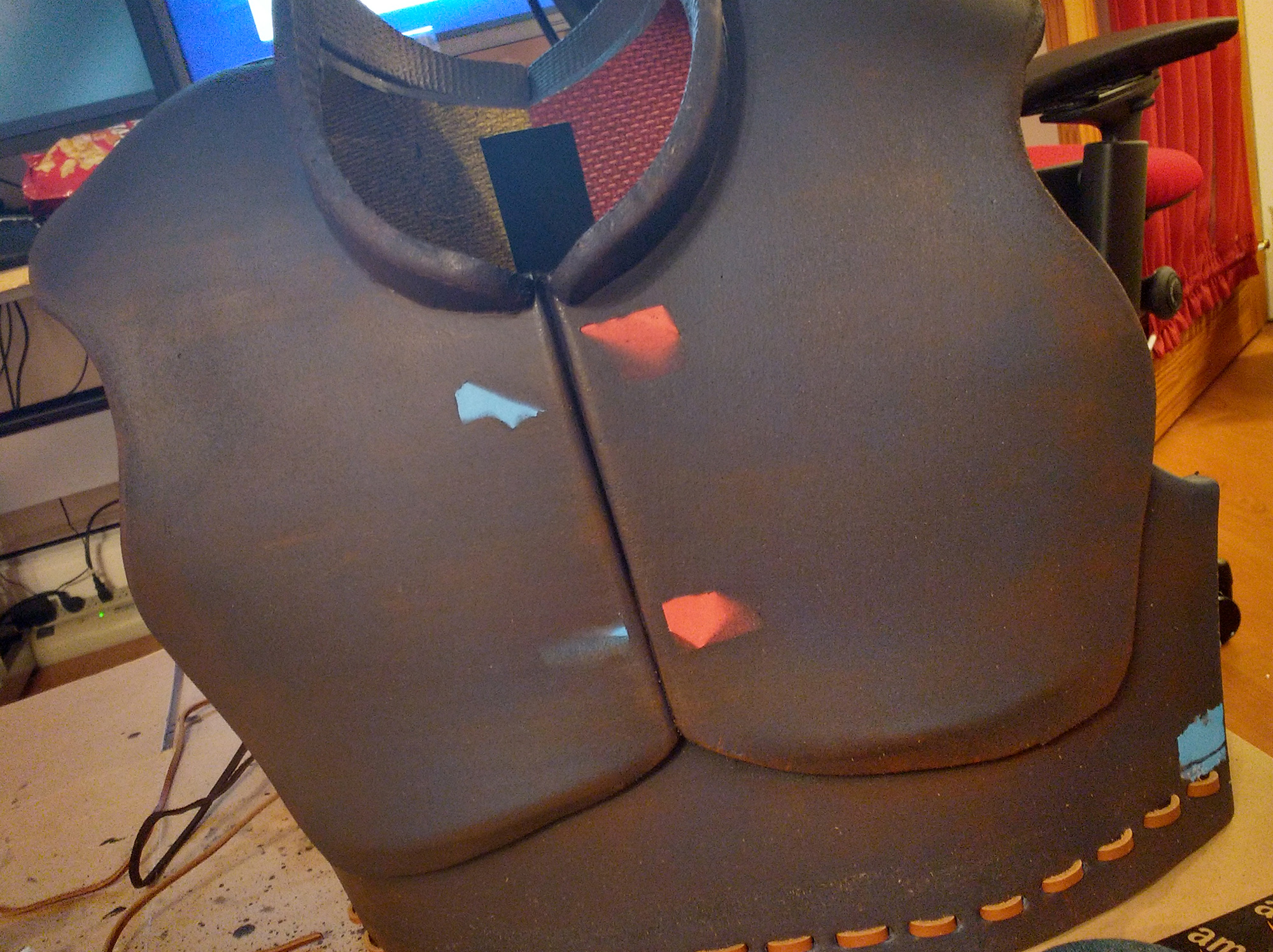
It turned out one of the chest buckles would be hidden by Geralt’s various straps, so I didn’t bother with that one – but I glued on the buckles. They didn’t hold very well, so I ended up hand sewing through the foam to make them more secure. This worked really well, and was necessary since these buckles were functional. (I’ll talk about making the buckles in a different post.)
And that was it! Foam armour complete!
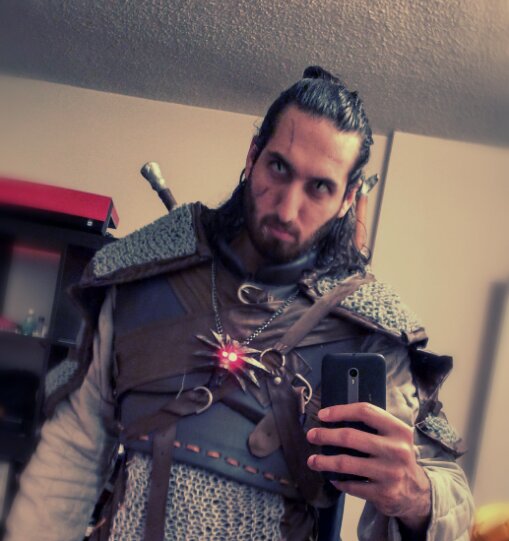

“Should I buy a sewing machine? Should I not buy a sewing machine? Should I buy a pizza?” So went the worries repeating in my mind as I stared deep into the computer’s screen, as deadlocked as the handsomest mutex.
Days passed without decision.
Guys I bought a sewing machine. It was around 90 Canadian dollars, and (thanks, in some part I’m sure, to retroactive rationalization) I’m happy with the decision.
Geralt’s sleeves are made of quilted leather, but I thought they looked more like a a suede or nubuck. Or you know, just a fabric. So I went with that.
Not sure where I got that idea, since they look like leather here.
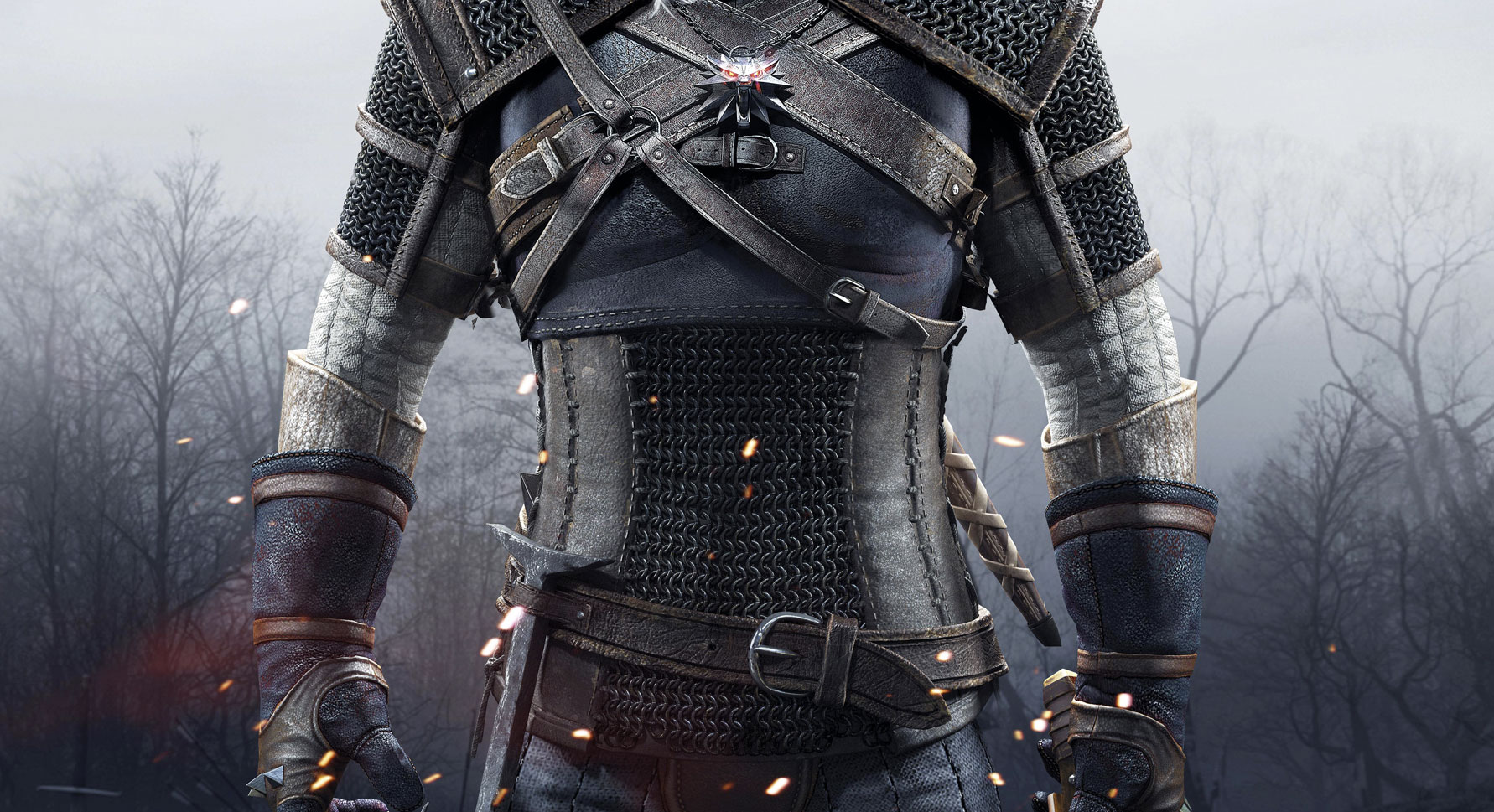
I ordered some fabric from fabric.com, which turned out pretty well despite their questionable stock count. (Twice they emailed me after I ordered to let me know they didn’t have stock. Twice on the same order, with different fabrics, days apart.)
The most visible parts of the shirt are the sleeves, so I started with those.
I cut a big rectangle with one dimension about the length of my arm, and started on the faux-quilting. By which I mean I folded the fabric and sewed along the fold line.
Like this, but better.
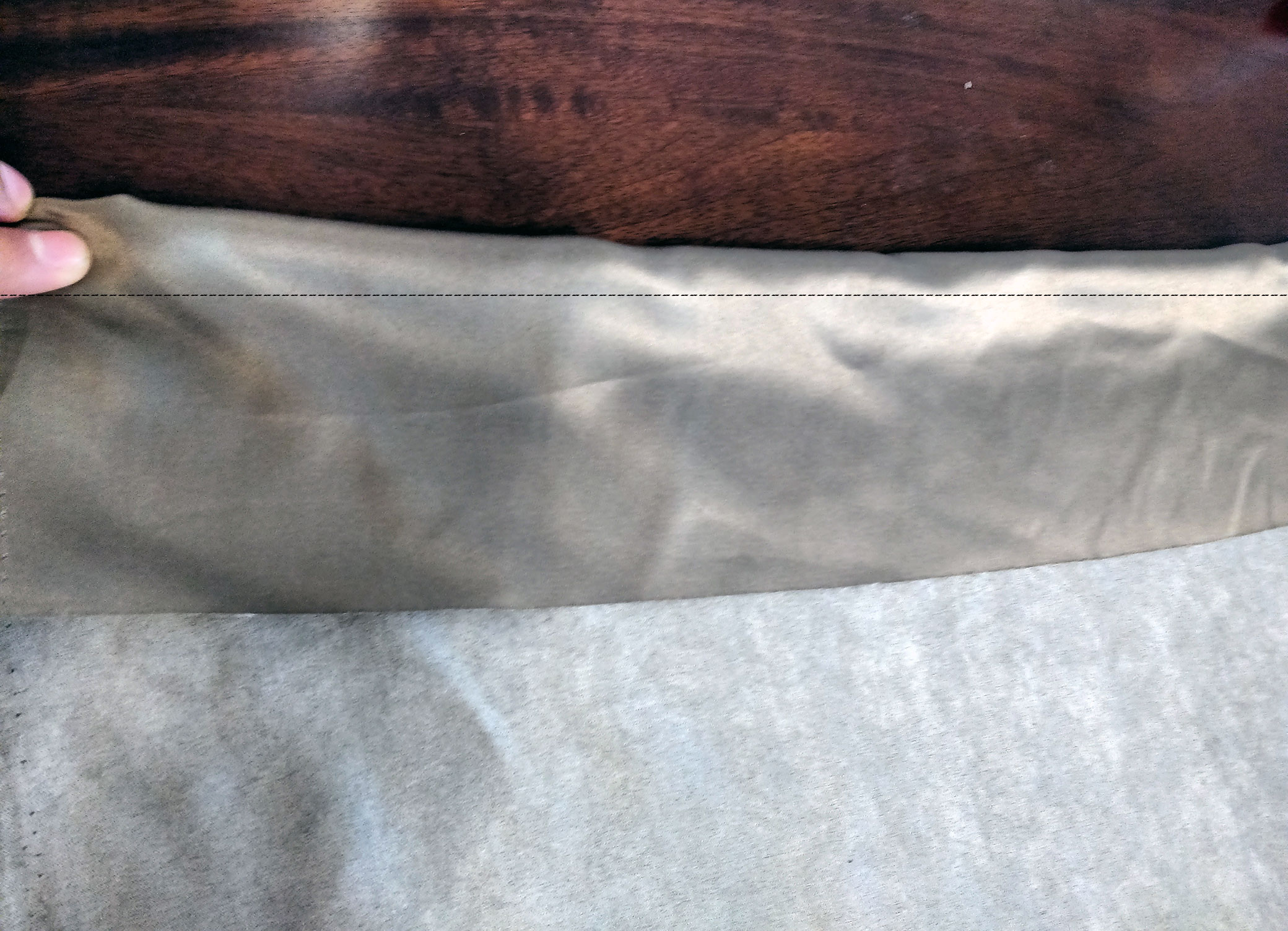
Fast forward like fifteen fold-and-sews later and I felt I had enough quilted fabric to comfortably wrap around two of my arms (individually). Hashtag sleeves.
I cut the fabric, and sewed both sections into tubes. Because what are sleeves but glorified tubes. Right? Right guys?
But now that I had sleeves, how could I hold them up? I decided to build a sort of sleeve harness, or shirt, if you will. I cut out some pieces of fabric that I hoped would roughly correspond to the front and back of a shirt and sewed them to arm-tubes. They didn’t quite fit the sleeves, but oh well the armour would hide that! (Actually, that turned out to be a bonus for pendant reasons.)
Here's me in the shirt, and the work-in-progress armour

There. Shirt done, unless we care about a bare midriff. Which, sigh, I guess Geralt doesn’t go around sporting. What a prude he is.
The bottom part of his shirt/armour is made of strips of leather on the sides and chainmail at the front and back. For the sides, I used the same quilting process on some fake leather (I actually meant to order a different, more textured one but I clicked add-to-cart on the wrong product. Because I’m terrible at internet shopping.)
I used larger, unquilted pieces of leather to back the chainmail (which I’ll go into later), and sewed it to the sides. And then sewed the whole thing to the bottom of the shirt.
After which, I absently watched TV as I punched holes (using a hole punch) and threaded the leather strips through.
Here's a picture of the threading in progress

The leather strip were from a bag of remnants from Michaels and were approximately $10. There were way more strips than I needed. I still have a bag full of them.
What am I going to do with these?


It was Halloween recently, and my months of reclusive toil finally came to fruition.
Perhaps you’ve heard of The Witcher, Geralt of Rivia. It was as he I dressed but with darker hair — my face artificially scarred and my eyes yellowed and cat-slit.
Geralt of Rivia costume

Costume making is bulky work, my apartment is now crowded with recently purchased crafting equipment – a heat gun, a rotary tool, and even a sewing machine; yards of fabric, and metres of interlocking foam; and can after can of sprayable paint.
Since I made the costume, it seems only fitting that I blog a bit about the process.
My Witcher costume includes: